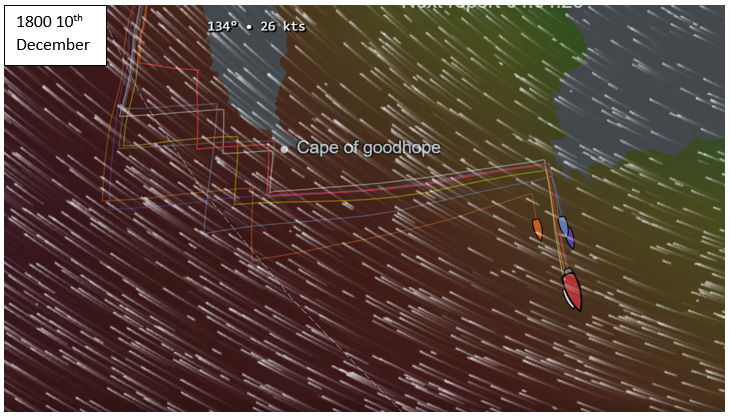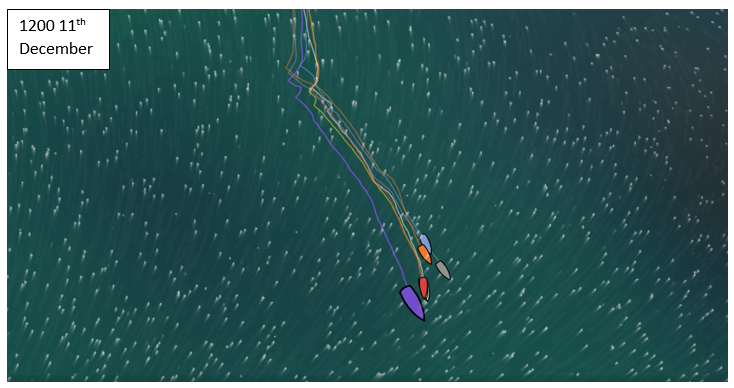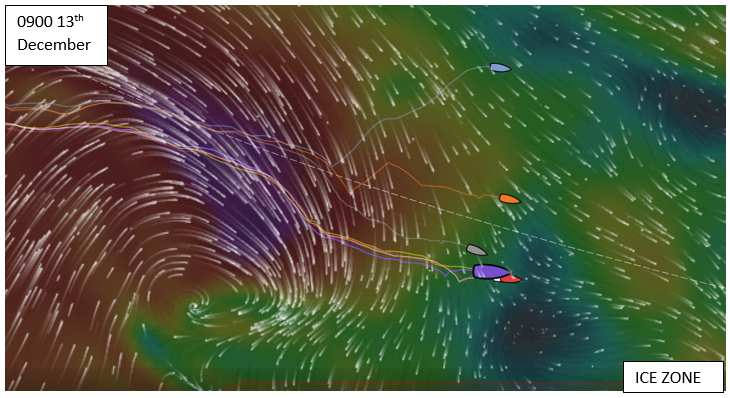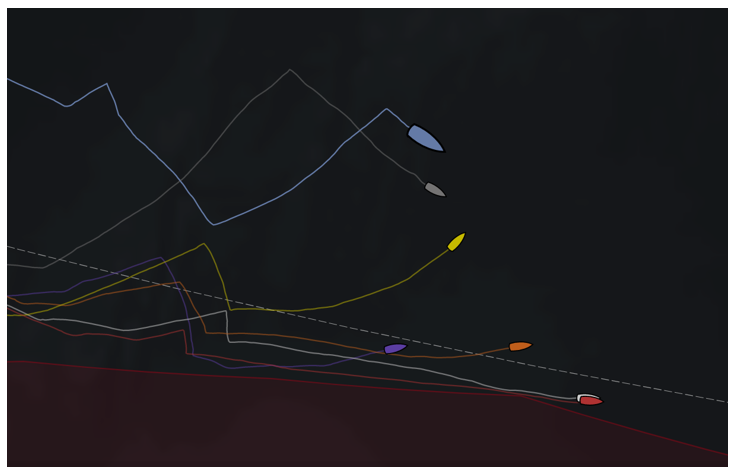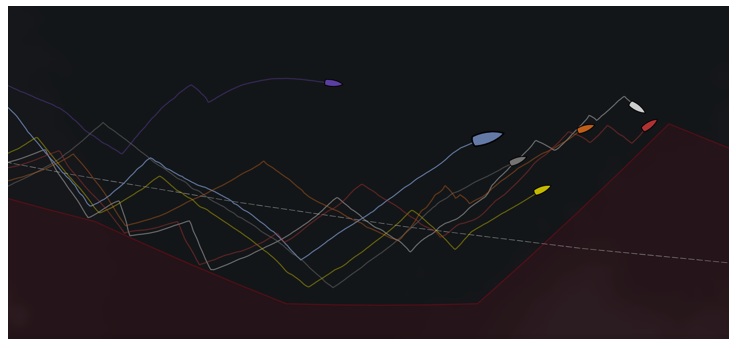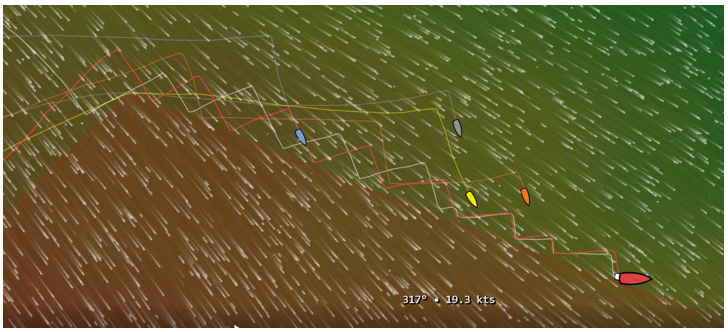Putting the final pieces together
Halfway through the big ocean leg and Christmas is getting nearer – but as we decorate our trees and get ready for the festive period, there are 7 teams with 70 people getting cold, wet and going at Mach10, or at least trying to!
In terms of weather, the big decisions in this leg from Cape Town to Melbourne were all made in the first week. The goal was to make it through in good shape, not make any rash decisions, deciding when to push and when to wind it back. For some crews it was about getting used to the big wild Southern Ocean. The idea is to make sure you are still with the pack in the final week and then look at how you are going to grab those DOUBLE points and turn the tables upside down.
So what has been happening, who has been making what decisions, right or wrong, good or bad, and what other factors are coming into play?
First position play
Another exciting loop with the stunning backdrop of Table Mountain saw strong breeze dominate and yet again Dongfeng and Mapfre led the charge out of the bay. But to all intents and purposes that was irrelevant and as they progressed in the lee of the land these two boats went offshore and were suddenly at the back of the fleet.
The first real play came with making use of the wind bend around the Cape of Hope and picking the moment to head to south and negotiate the high pressure. The big surprise here was Vestas 11th Hour Racing who didn’t attack the wind bend like the other teams and look like they bailed out of potentially heading south first, taking a big loss. The team openly admitted that this was a mistake but ultimately they were still happy they were all in one piece: something that will constantly be a discussion this leg.
Transtitioning the High
It always comes down to subtle positioning differences when transitioning a high pressure ridge and having the ability to accept that the position where you come out is the position where you come out. Quite simply it is never like the models and a 100m difference can be completely different for two boats.
However, the overall patterns hold true and with that in mind Akzonobel made the biggest gains with a late gybe which meant they were able to hold slightly further west. This got them into the stronger breeze sooner and they sailed around the outside of the fleet.
There became a natural divide in the fleet as they exited the high pressure as teams knew that the sooner they went bows down and faster, the quicker they were heading for the finish. For those behind this is the way to gain rather than simply following the leaders, and so you saw two mini fleets develop as they focused on moding and what sail they should be putting up .
How far south the teams wanted to be versus heading east towards the finish was also a tough call as in the back of their minds was deciding how they wanted to set up for a low pressure that still hadn’t developed.
The GREAT storm
As forecasts continued the secondary low that developed became less intense than when the teams set off from Cape Town but with grib values still showing 45 KT it was clear there were going to be wind speeds well in excess of 50 KT.
The strategy that played out here varied from team to team based on experience and how they balanced the rewards of pushing hard with the risk of damage. The northerly group fractured here with Turn the Tide continuing to position further north to avoid the worst conditions and Vestas 11th Hour looking to make up for their earlier loss cleverly positioned themselves further south.
As the storm built the teams were all slowly converging on the ice zone to the south. While there is better wind and better shifts in the south, the building breeze on the front edge of the storm meant the group to the south would have to weather some of the strongest breeze at a narrower (and therefore slower) true wind angle (TWA) in order to avoid going into the ice zone. This gave Vestas the option to sail at their fastest angle and pull themselves right back into the front pack.
From here it was a case of those further west and south gained as they stayed ahead of the fast approaching front for longer and therefore made good progress east at consistent less squally conditions.
Turn the Tide in their more northerly position saw some of the worst conditions, with much more squally conditions as they were nearer the frontal band and the wind began to lift them further. The result was that Mapfre and Dongfeng made a jump on the fleet and Vestas a jump on Brunel and Akzonobel.
TAKING ITS TOLL
Teams reported winds in excess of 55 KT and the footage coming off the boats showed people disappearing off the helm, broaching and Akzonobel taking the biggest hit with a gybe going badly.
The resulting broken battens and damaged mast track saw them trying to piece the boat back together and sailing for 2 days with just a headsail, bleeding miles that they won’t make up. The issue is that the stop in Melbourne is a short pitstop so there are no shore crew allowed on the boat to get ready for the next leg start in the New Year.
This leg could turn into a costly, possibly race position deciding leg, with double point scoring and a nagging element of doubt over the damaged kit for the next leg.
Unfortunately, it has not only been boats that have been damaged but also people, with reports of a potential broken arm on Scallywag as they line up yet again to match race Turn the Tide to the finish.
ICE ZONE STRATEGY
As the winds abated the strategy was clear: squeeze along the ice gate, picking your shifts to gybe back down on. Pressure was still king to the south and so the fleet all headed back south with now three groups clearly defined.
Mapfre and Dongfeng will be in their own race to the finish, 100 miles ahead of the next boat. However, stranger things have happened and Vestas 11th Hour will be desperately clinging on to their coat tails looking for an apt opportunity.
Brunel identified that their race is now with Scallywag and Turn the Tide and pushed north on what looked like a bad shift to position with their new fleet.
Sadly, with their damage repaired, Akzonobel will be bringing up the rear over 300nm behind the leaders, and look set to be spending Christmas at sea.
Overall the goal is to always be inside the shift and pressure: the closer to the ice gate you can remain the better but when gybing takes 40+minutes and the crew are all knackered then it is hard to always be inside your competitors.
THE RACE FOR CHRISTMAS
Hitting the Australian shoreline on or before Christmas Day will be on all these sailors minds and the race is on in this final week to make that happen, albeit with moving goal posts in the form of the Ice Gates.
Ultimately the ice gate is governing the strategy and there isn’t really a lot to it other than staying in the narrow gap of wind along the ice gate, way south of the high pressure and riding along the edges of the fast moving low pressure much further south. This has resulted in a gybe off for the leaders as there is a better angle to the south and better pressure.
It varies slightly depending on where you are, with an easier time being afforded to the chasing pack as they make a good angle east, but ultimately the teams will all be back to getting little sleep as they continue to gybe downwind.
FRONTAL TRANSITIONS
The critical things on this leg will be frontal transitions. As the teams can’t get low enough to ride along to the front of systems they will have to deal with frontal systems rolling over the top of them and very much the trailing end of the front where they are less defined and the transition zone is far wider.
On the 21st there is likely to be the next split and an opportunity for the rich to get richer. If the leaders manage to stay ahead of the front they can make a fairly good straight line to the finish leaving the pack behind to continue further south to avoid the high pressure following behind.
It is likely the fleet will compress and extend like an elastic band as this frontal system approaches and they try hard to stay ahead but most likely will not achieve it. Therefore, managing the transition and positioning to be south once it has passed will be key, as from here on in it is pretty much a drag race to the finish.
FINISH
Current ETA has the leaders in on Christmas Day evening local time. With the leaders so close I am sure the final throes of pushing up through Port Phillip Bay to Melbourne will be a spectacle to watch!

